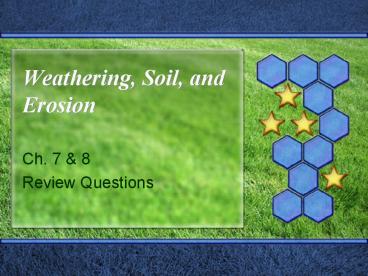Weathering, Soil, and Erosion - PowerPoint PPT Presentation
1 / 17
Title:
Weathering, Soil, and Erosion
Description:
Weathering, Soil, and Erosion Ch. 7 & 8 Review Questions The agent of mechanical weathering in which rock is worn away by the grinding action of other rock particles ... – PowerPoint PPT presentation
Number of Views:464
Avg rating:3.0/5.0
Title: Weathering, Soil, and Erosion
1
Weathering, Soil, and Erosion
- Ch. 7 8
- Review Questions
2
The agent of mechanical weathering in which rock
is worn away by the grinding action of other rock
particles is
- A. erosion
- B. cracking and peeling
- C. abrasion
- D ice wedging
3
What kind of weathering causes the mineral
composition of rocks to change?
- A. mechanical
- B. permeable
- C. chemical
- D. general
4
A hot and wet climate causes weathering to take
place
- A. slowly
- B. at the same rate as when the limate is dry and
cool - C. unevenly
- D. rapid
5
Soil formation begins with the weathering of
- A. litter
- B. rock
- C. the A horizon
- D. humus
6
The mixture of rock particles, minerals, decayed
organic material, air, and water is called
- A. gravel
- B. litter
- C. silt
- D. soil
7
The decayed organic material in soil is called
- A. silt
- B. litter
- C. humus
- D. clay
8
Which soil particle is the largest?
- A. gravel
- B. sand
- C. silt
- D. clay
9
Which soil particle is the smallest?
- A. sand
- B. gravel
- C. clay
- D. silt
10
The layer of soil in which topsoil is found is
the
- A. A horizon
- B. B horizon
- C. C horizon
- D. bedrock
11
Most of the work of mixing humus within the soil
is done by
- A. fungi
- B. ants
- C. earthworms
- D. bacteria
12
The solid layer of rock beneath the soil is
called
- A. bedrock
- B. gravel
- C. the B horizon
- D. subsoil
13
The process by which natural forces move
weathered rock and soil from one place to another
is called
- A. soil conservation
- B. deposition
- C. abrasion
- D. erosion
14
The process in which sediment is laid down in a
new location is called
- A. weathering
- B. deposition
- C. erosion
- D. mass movement
15
Landslides, mudflows, slump, and creep are all
examples of
- A. mechanical weathering
- B. runoff
- C. mass movement
- D. soil formation
16
Mass movement is caused by
- A. plucking and abrasion
- B. gravity
- C. chemical weathering
- D. erosion and deposition
17
(No Transcript)































